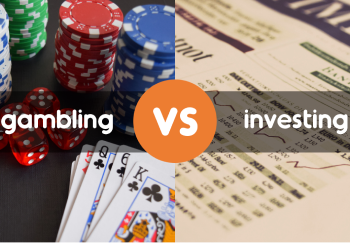The Good Old Days,
and The Fantastic Days Ahead...
May 7, 2019
The good old days...
Many years ago, when I was a stockbroker, I researched companies listed on various stock exchanges. Based on my research, I would recommend buying or selling the listed shares of specific companies to professional fund managers who typically managed unit trusts or mutual funds. The fund managers would make investment decisions based on their own research and opinions. They would also consider my research versus the opinions and research of my competitors to make their final investment decisions. Most of the time, they would consider my past track record to tilt them in the decision whether to accept or reject my recommendation. Any such shares bought or sold as a result of the investment manager’s decision would be allocated or removed from a unit trust.

Fund managers would reward the grunt work of investment analysts like myself with buy and sell orders which generated commission income for stockbrokers like me. This then lucrative stockbroking business was possible because of the value of timely and processed information called “investment research”.
This was at the time when the fastest form of communications was a little black box called a fax modem. It was a time when an hitherto obscure word processing software called “Microsoft Word” was giving then competitor “WordPerfect” a run for its money. It was a time when I could add value to fund managers around the world (mainly via expensive international phone calls) simply by compiling information and making sense of it – in a timely fashion when few others understood the value of that information.
At that time, I would rush to the office and grab the newspapers. I had to read and digest the factual news and generate insights or at least, express a preliminary opinion, pending more facts or analyses. We had to pay the newspaper vendor a bit more so that he would bring the newspapers to us first before he delivered it to others in the same building! The irony was that the news vendor already had the information before me, but he was not in a position to analyse, comment or form an opinion that others would believe or consider. The real irony, however, was that the information in the printed newspaper every morning – was already known to the reporter and/or his colleague at least 3 hours before the printing presses went to work!
In those good old days, personal relationships played a key role in the credibility of information. We had to work hard to earn the trust of our clients – the fund managers. And they would not relent just because a few recommendations were right, unless for whatever reason, they just simply adored you at first sight or fell into a believing trance at the sound of your voice via telephone cables across the ocean floor!
And you would have to go the extra mile to convince them that they are the first client you are telling. Obviously, they would not be happy if they’re number two or more in the queue. Quite understandably when each client conversation would be 20 minutes or more! It was a hard choice for me to decide who to call first. Not only that, I had to find resourceful ways to supplement publicly available information (already in print media) to win the trust of clients and to deliver the convincing push for the investment decision to go my way.
For example, in covering a tyre exporting company, I decided to camp outside the factory and count the number of fully laden lorries going to the port for a week, enabling me to estimate the tyre exports. This allowed me to conclude that the company was doing much better than what my competitors believed, and it was a reasonable and fair advantage – enough for my clients to believe me and buy the stock of the tyre company.
So basic was the information flow then, that the value of information was quite undiscovered by the lack of will and ability to analyse such information. But more, it was the fact that many fund managers were willing to listen to me rather than a newspaper vendor – that made the difference in those good old days! In those good old days, resourceful investment analysis added value.
Today, all the advantages of the good old days have been wiped out by instant data at one’s mouse click. There is no need for the fund manager to know the person providing the information. It’s instant data available to everyone. There is no need for me to camp outside the tyre company anymore (yes, tyre companies still exist), but tyre export data can be provided by the company itself on its website for all to see!
So, what’s my point?
The ability for humans to capitalise on information inefficiencies and profit from information advantage is now very limited - with the proliferation of the internet and instant data communications. Compared to the good old days, global investment markets are today more correlated than ever before!
Any single impactful news will play out as instant knowledge across markets - as the earth turns every 24 hours. Now, each geographic investment market that wakes up gets to churn in the wake of the market that just closed its trading. Every single impactful news rolls across every investment market time zones like a tsunami. This was not the case in the good old days.
Today, anyone can easily invest in all the major investment markets of the world, right from the mobile phone. This was not possible on such a ubiquitous scale some 10 years ago. That’s very recent.
My point is “We’re still in the early days of technology impacting the way we invest.”
You may not recall, but the iPhone was launched just 12 years ago. And just 8 years ago, the iPad was launched. It started a revolution in user interfaces from rigid keyboards to hand gestures. I am just waiting for voice commands to come into its full, and impact investing, insurance and health. My point is that user interface advances that our kids are so familiar with - are quite recent. I believe user interface innovation will only accelerate. But let’s get back to the impact of technology on investing behaviour.
The Investment Industry is the “Frog in the Boiling Pot”
Today, the traditional players are still hoping the world will remain the same “good old days” – like I wanted it to be – when I faced disruption as an investment analyst and stockbroker – and pivoted to developing innovative financial advisory services, segregated investment management services and private banking. I eventually moved on, pulled by moral and pushed by competitive circumstances into turning around life/health/general/group/individual insurance companies - developing portable hospital insurance, outpatient health analytics and absentee management, flexible sponsored and voluntary employee benefits and digital financial services.
Yet all this while, I observed through the corner of my eye how the investment industry – at least in Asia – continued to hold on to what it knew – and not what it knows. It’s the proverbial “frog in the boiling pot” syndrome.
If you are led by those who know what they already know and know so well over so many years, without cross-industry experience and passion for embracing (not ignoring) the relentless march and acceleration of technology, you risk learning little from such leaders in your next few years. ! I was tempted to add “career” between “next” and “few”, but I realised that the word career is going to be a historic word in time to come. With technology, jobs and careers will take new meaning. For such leaders, it’s only a matter of a few years to the finishing line. For those of you with a much longer runway, it might be a disruption you should have seen coming.
The investment market is still dominated by unit trusts or mutual funds. Why are unit trusts still the main product sold to end-investors? Read my blog on “What You Should Know About Unit Trusts”.
Unit trusts are still parlayed to the innocent end-investor in operational structures that are geographically regulated and internationally patchworked. Unit trusts are still run, ultimately, by a human investment manager. The evidence clearly shows that the human investment manager is unable to deliver consistent outperformance against the broad market on an active basis over time.
You should not be surprised. With the instant data explosion, no human investment manager can really make sense of the market in its entirety. A human investment manager can only address a sliver of the investment market - and only that sliver - based on experience and knowledge, both of which are historical by the instant data (streaming) standards our kids already know and play with every day!
What Fantastic Days Lie Ahead?
Indeed, allow me to introduce the march of machine learning AI. Machine learning (ML) is not new, by the way. ML has perhaps started taking off mainstream in the last 3 years.
ML is defined as a form of artificial intelligence (AI) that provides computer systems the ability to automatically learn and improve from experience without being explicitly programmed. The computer programs access data and use it learn for themselves. It begins with observations or data and looks for logic patterns to make predictions. ML allows the computers to learn automatically without human intervention or assistance and adjust predictions or actions accordingly.
It is a form of applied AI which allows the computing machine to be trained on historical data sets – but done in such a way that the machine thinks it is existing in the past. The machine is asked to predict the next result (which we already know based on the actual historical result). We then tell the machine the actual result for which the machine compares with its own original forecast.
By feeding the machine successive data year by year, the machine can see its prediction errors and “learn” from its “mistakes” by correcting the complex number of variables to make a new prediction. Once this training is over, the machine can correct itself as it confirms new actual data versus what it predicted earlier.
In applying ML to investments, SqSave uses one data point. The price of an investment instrument – which represents an asset class, for example, a developed country bond, an emerging market equities index, precious metals such as gold, a region such as ASEAN, etc. These asset classes are well and deeply represented by Exchange Traded Funds (ETFs) which like unit trusts, are a form of Collective Investment Schemes (CIS). However, unlike most unit trusts or mutual funds, ETFs are transparent in terms of their respective constituent investments, priced in real time being traded on stock exchanges, low cost and liquid, among others.
In using this single price parameter, SqSave interprets the movement of the price over time as “return”, and how the price got from point A to point B in the timeline is deemed to be “volatility” or “risk”. The path (of highs and lows) represents the risk while the price difference over the same time line gives the return. Using a single piece of data over time, SqSave can determine the return and the risk that it took to get there.
Imagine this done over billions of data points. No human can do it. But SqSave AI can.
Apply machine learning AI to investing, and a whole new world opens. To be sure, the machine must have a reference framework to operate and generate predictions. At SqSave, we use the Nobel Prize winning Modern Portfolio Theory (“MPT”), the mathematics of which is well-known to every basic finance student. According to MPT, we can find – right now – when you ask for it – a combination of investment securities whose predicted risk-return behaviour using ML gives an overall risk rating that matches your personal risk profile (read my other blog about Risk Profiling) and generates the highest predicted return, based on latest real-time data. Wouldn’t this portfolio be the most optimal for you?
And that’s what SqSave will get for you, instantly.
I have said goodbye to the good old days, and I look to the fantastic days ahead. What about you?
More Articles more

Why Replace The Human Investment Manager?
May 21, 2019 | Victor Lye, CFA CFP®
When investors ask me what I do, I cheekily tell them that I intend to replace their human investment manager. Read more

Smart Investing with Global Diversification at SqSave
Jun 13, 2019 | Victor Lye, CFA CFP®
Internet social media has shifted the
way news or facts are delivered and
perceived – with profound implications
for the way we should invest.
Read more

Psst! Are you investing, gambling or speculating?
Apr 5, 2019 | Victor Lye, CFA CFP®
Many people say they invest. But they
are really gambling or speculating!
What about you?
Read more